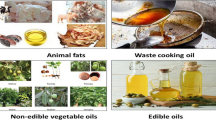Abstract
Several commercially available lipases have been evaluated with regard to their substrate specificity in the esterification of fatty acids having specific positions of cis double bonds, e.g. petroselinic acid (n-12 18:1), alpha-linolenic acid (n-3 18:3), gamma-linolenic acid (n-6 18:3), stearidonic acid (n-3 18:4), dihomogamma-linolenic acid (n-6 20:3), eicosapentaenoic acid (n-3 20:5) and docosahexaenoic acid (n-3 22:6), with n-butanol. A common feature of most lipases, e.g. those from Penicillium cyclopium, Candida cylindracea, Mucor miehei, Rhizopus arrhizus and Penicillium sp. is that fatty acids having the first double bond from the carboxyl end as a cis-4 (n-3 22:6), cis-6 (n-12 18:1, n-6 18:3, n-3 18:4) or a cis-8 (n-6 20:3) double bond are strongly discriminated against compared to the other fatty acids, such as myristic acid (14:0), the reference standard, and n-3 18:3. In the case of the lipase from porcine pancreas, however, the discrimination against the above fatty acids is not as strong as with the other lipases. In contrast, the lipase from Chromobacterium viscosum shows a preference for n-12 18:1, n-6 18:3 and n-3 18:4. The observed substrate specificities can be utilized for enrichment of particular fatty acids by lipase-catalysed kinetic resolution from fatty acid mixtures, derived from naturally occurring fats and other lipids.
Similar content being viewed by others
References
Baillargeon MW, Sonnet PF (1991) Selective lipid hydrolysis by Geotrichum candidum NRRL Y-553 lipase. Biotechnol Lett 13:871–874
Chen C-S, Sih CJ (1989) General aspects and optimization of enantioselective biocatalysis in organic solvents: the use of lipases. Angew Chem Int Ed Engl 28:695–707
Drevon CA (1992) Marine oils and their effects. Nutr Rev 50:38–45
Hayes DG, Kleiman R (1992) Recovery of hydroxy fatty acids from lesquerella oil with lipases. J Am Oil Chem Soc 69:982–985
Hills MJ, Kiewitt I, Mukherjee KD (1989) Enzymatic fractionation of evening primrose oil by rape lipase: enrichment of gamma-linolenic acid. Biotechnol Lett 11:629–632
Hills MJ, Kiewitt I, Mukherjee KD (1990a) Lipase from Brassica napus L. discriminates against cis-4 and cis-6 unsaturated fatty acids and secondary and tertiary alcohols. Biochim Biophys Acta 1042:237–240
Hills MJ, Kiewitt I, Mukherjee KD (1990b) Enzymatic fractionation of fatty acids: enrichment of gamma-linolenic acid and docosahexaenoic acid by selective esterification catalyzed by lipases. J Am Oil Chem Soc 67:561–564
Horrobin DF (1992) Nutritional and medical importance of gamma-linolenic acid. Prog Lipid Res 31:163–194
Hoshino T, Yamane T, Shimizu S (1990) Selective hydrolysis of fish oil by lipase to concentrate n-3 polyunsaturated fatty acids. Agric Biol Chem 54:1459–1467
Klibanov AM (1990) Asymmetric transformations catalyzed by enzymes in organic solvents. Acc Chem Res 23:114–120
Langholz P, Andersen P, Forskov T, Schmidtsdorff W (1989) Application of a specificity of Mucor miehei lipase to concentrate docosahexaenoic acid. J Am Oil Chem Soc 66:1120–1123
Mbayhoudel K, Comeau L-C (1989) Obtention sélective de ll'acide pétrosélinique à partir de l'huile de fenouil par hydrolyse enzymatique. Rev Fr Corps Gras 36:427–431
Mukherjee KD (1990) Lipase-catalyzed reactions for modification of fats and other lipids. Biocatalysis 3:277–293
Mukherjee KD, Kiewitt I (1991) Enrichment of gamma-linolenic acid from fungal oil by lipase-catalysed reactions. Appl Microbiol Biotechnol 35:579–584
Osterberg E, Blomstrom A-C, Holmberg K (1989) Lipase catalyzed transesterification of unsaturated lipids in a microemulsion. J Am Oil Chem Soc 66:1330–1333
Princen LH, Rothfus JA (1984) Development of new crops for industrial raw materials. J Am Oil Chem Soc 61:281–299
Rangheard M-S, Langrand G, Triantaphylides C, Baratti J (1989) Multi-competitive enzymatic reactions in organic media: a simple test for the determination of lipase fatty acid specificity. Biochim Biophys Acta 1004:20–28
Tanaka Y, Hirano J, Funada T (1992) Concentration of docosahexaenoic acid in glycerides by hydrolysis of fish oil with Candida cylindracea lipase. J Am Oil Chem Soc 69:1210–1214
Author information
Authors and Affiliations
Additional information
Dedicated to Prof. David A. Walker, Robert Hill Institute, Department of Animal and Plant Sciences, University of Sheffield, Sheffield, UK, on the occasion of his sixty-fifth birthday on 18 August 1993
Correspondence to: K. D. Mukherjee
Rights and permissions
About this article
Cite this article
Mukherjee, K.D., Kiewitt, I. & Hills, M.J. Substrate specificities of lipases in view of kinetic resolution of unsaturated fatty acids. Appl Microbiol Biotechnol 40, 489–493 (1993). https://doi.org/10.1007/BF00175736
Received:
Revised:
Accepted:
Issue Date:
DOI: https://doi.org/10.1007/BF00175736




